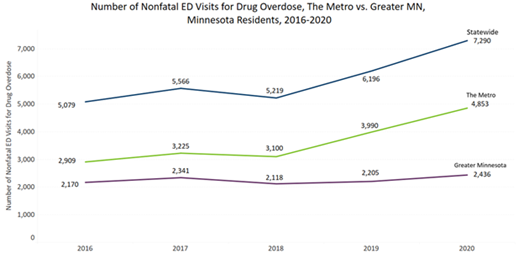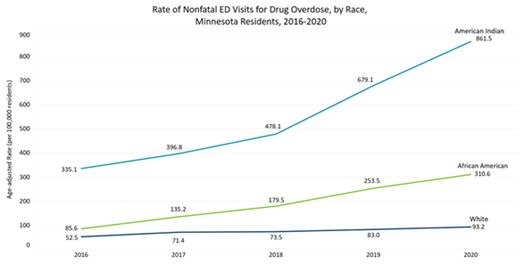Nonfatal drug overdoses increased during COVID-19 pandemicMinnesota hospitals report upward trend in nonfatal overdoses, mirroring fatal overdose dataImproving health and wellness is possible for anyone who uses drugs, including the more than 14,000 Minnesotans who had an overdose treated at a hospital in 2020. In fact, in 2020, for every overdose death of a Minnesota resident, there were 14 nonfatal overdoses reported. The Minnesota Department of Health (MDH) reported an 18% increase in nonfatal, emergency department-treated drug overdoses in 2020 compared to 2019. Nonfatal overdoses rose from 6,196 in 2019 to 7,290 in 2020. Opioids and stimulants drove much of the increase, as they were involved in 57% of emergency department visits for nonfatal overdoses.
"The report on nonfatal overdoses in Minnesota is a reminder that so many lives are tragically impacted by substance use," said Minnesota Commissioner of Health Jan Malcolm. "The COVID-19 pandemic has been the biggest public health issue in the world for almost two years now, but the other pressing public health issues have not gone away. The opioid epidemic continues to be pervasive and requires continuing, comprehensive drug overdose prevention and response efforts." The harms of drug overdoses are another area of wellness, where the inequities experienced by communities of color, as a result of systemic racism and its influence on health, contribute to the greater burden among Minnesota's communities of color. The data shows American Indians were nine times as likely to experience a nonfatal overdose than white Minnesotans. Black Minnesotans were three times as likely as white Minnesotans to experience a nonfatal overdose.
"As with fatal overdose data, we see populations most impacted by systemic racism are more often affected by substance use," said MDH Overdose Prevention Supervisor Dana Farley. "Recovery has a greater chance of success when communities are involved. Systemic racism and lack of access to recovery resources hinders recovery efforts for many Minnesotans. The Minnesota Department of Health is working to amplify the work of our community partners who provide needed support for people in their recovery journey." Naloxone, also known as Narcan®, is a life-saving medication that can be used to reverse the effects of opioids during an overdose. Anyone can carry naloxone, and it is available through a number of sources in Minnesota. More information on and where to find naloxone can be found on the MDH website. Read more about nonfatal overdoses in Minnesota in the Nonfatal Emergency Department Visits for Drug Overdose Among Minnesota Residents 2016-2020 (PDF) report. Visit the MDH Drug Overdose Dashboard to learn more about overdose data, opioid emergency response, lifesaving naloxone, and preventing the demand for drugs. -MDH- Media inquiries: Julie Bartkey |
Thursday, September 30, 2021
News Release: Nonfatal drug overdoses increased during COVID-19 pandemic
Subscribe to:
Post Comments (Atom)





No comments:
Post a Comment